
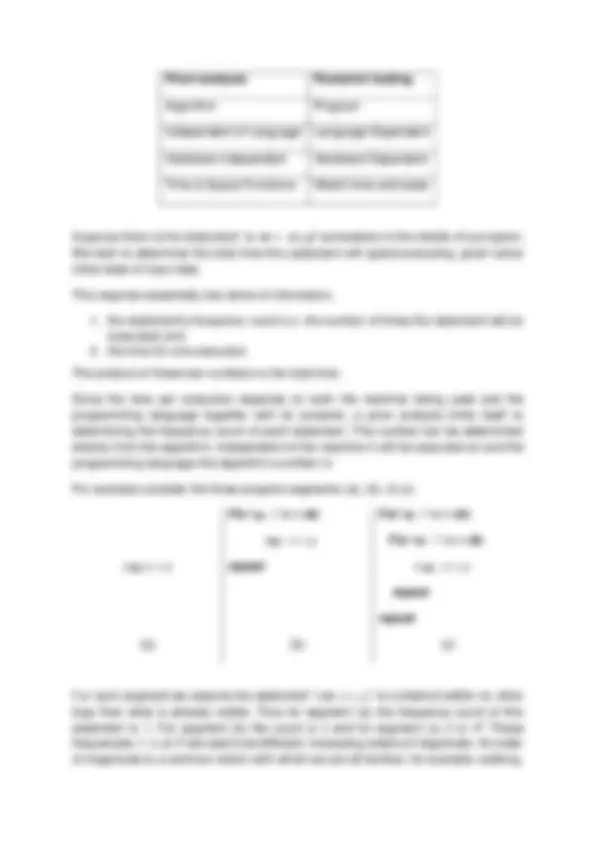
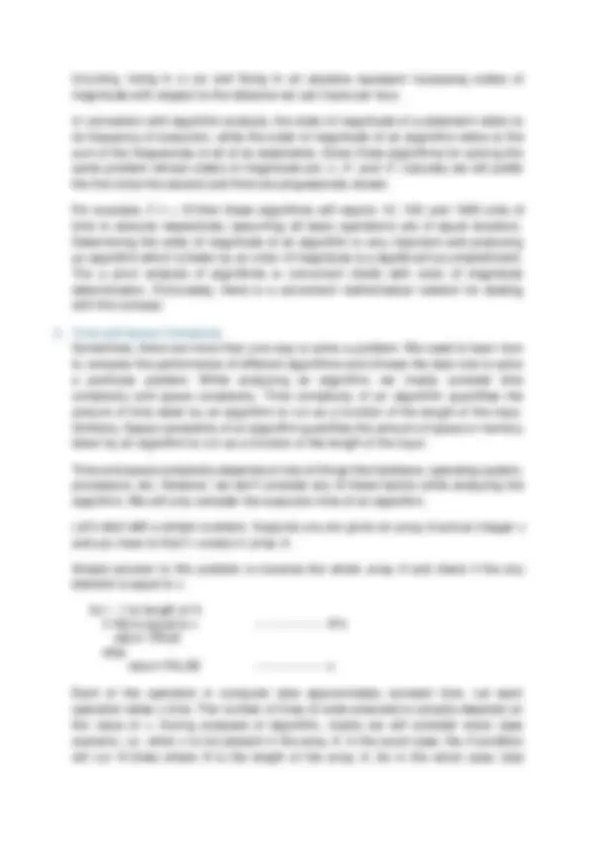
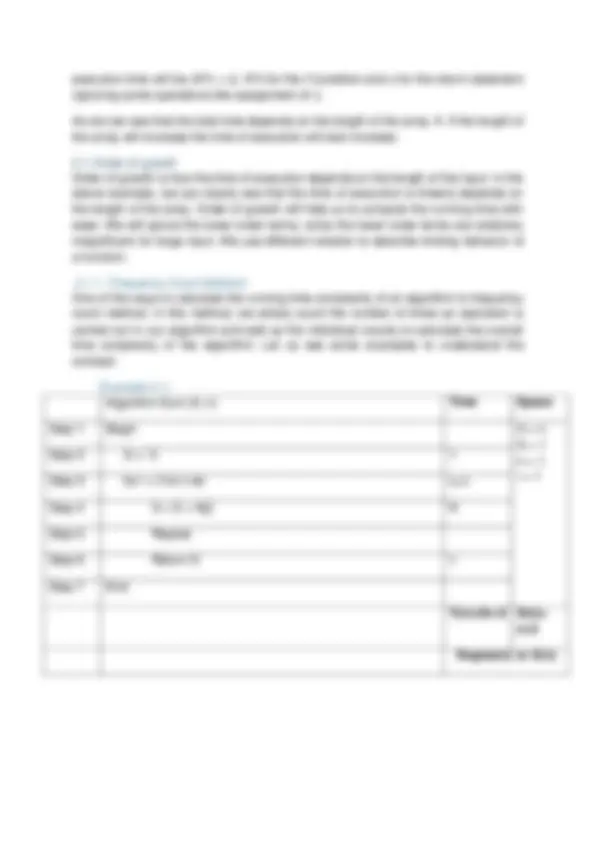
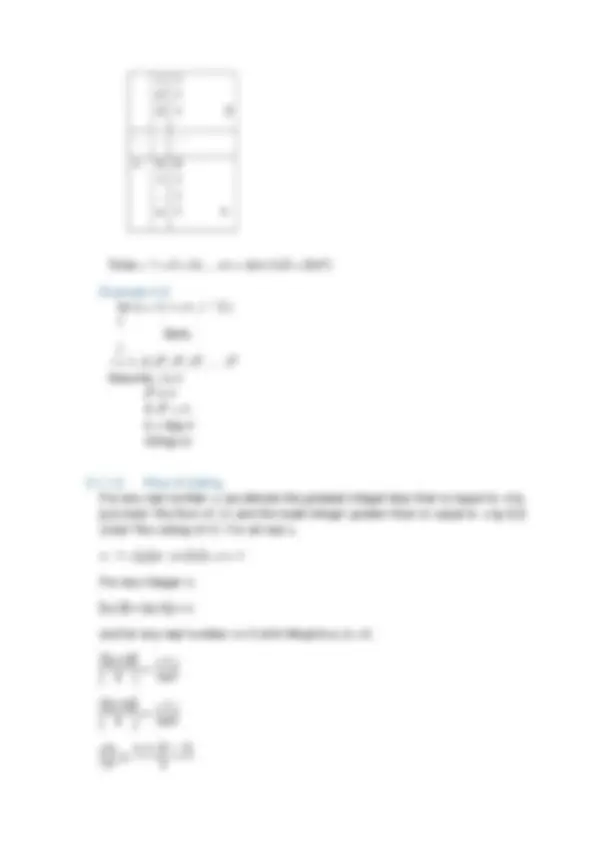
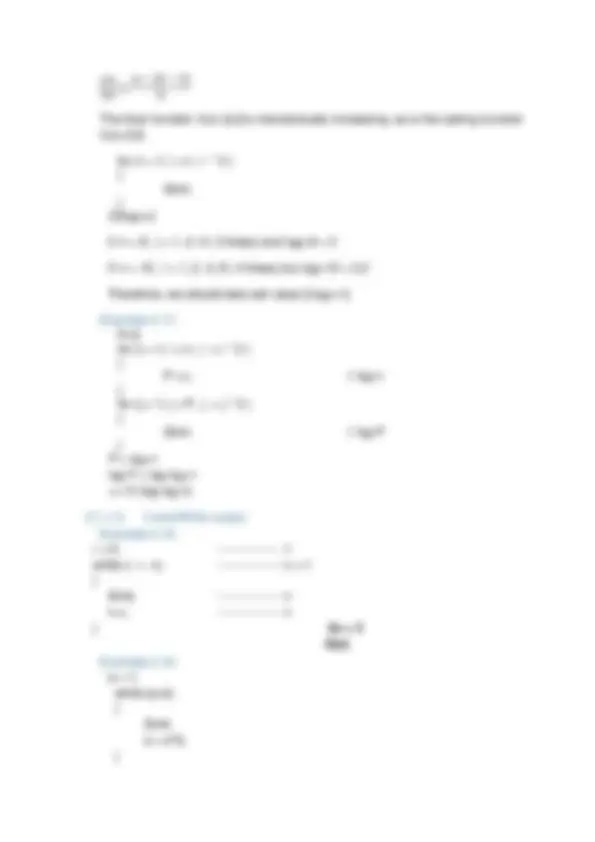
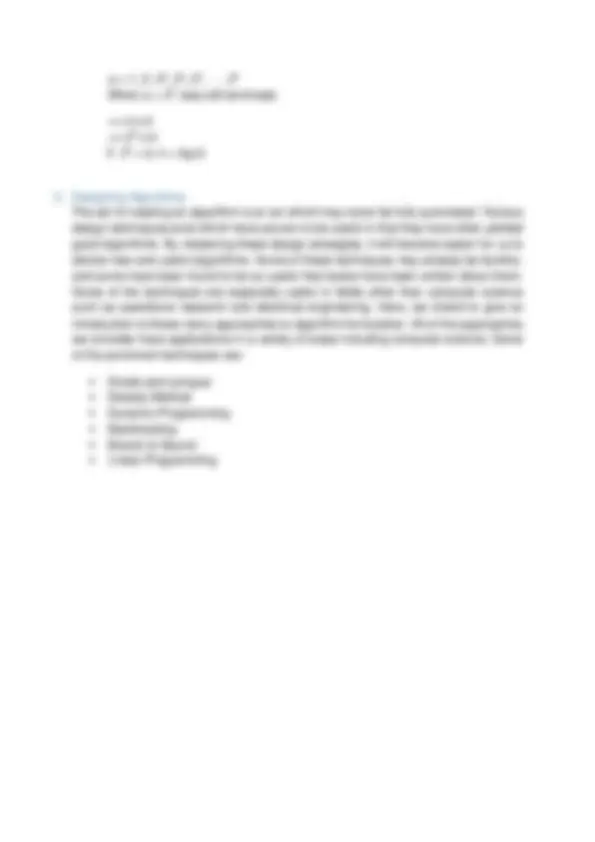


Study with the several resources on Docsity

Earn points by helping other students or get them with a premium plan


Prepare for your exams
Study with the several resources on Docsity

Earn points to download
Earn points by helping other students or get them with a premium plan
Community
Ask the community for help and clear up your study doubts
Discover the best universities in your country according to Docsity users
Free resources
Download our free guides on studying techniques, anxiety management strategies, and thesis advice from Docsity tutors
Topics coverd in this document 1. Analysis of algorithm 1.1.Priori analysis: 1.2.Posteriori testing: 2. Time and Space Complexity 2.1.Order of growth 3. Designing Algorithms
Typology: Cheat Sheet
1 / 10

This page cannot be seen from the preview
Don't miss anything!







Text:
Why do we bother to analyze an algorithm?
For some of us analyzing algorithms is an intellectual activity that is fun.
Another reason is the challenge of being able to predict the future and even
though we are narrowing our predictions to algorithms, it is gratifying when we
succeed.
A third reason is because computer science attracts many people who enjoy
being efficiency experts. Analyzing algorithms gives these people a chance to
exhibit their skills by devising new ways of doing the same task even faster.
This tendency has a large payoff in computing where time means money and
efficiency saves dollars.
As an algorithm is executed, it makes use of the computer’s central processing unit
( CPU ) to perform operations and it uses the memory (both immediate and auxiliary)
to hold the program and its data. Analysis of algorithms refers to the process of
determining how much computing time and storage an algorithm will require. This area
is a challenging one which sometimes requires great mathematical skill. One important
result of this study is that it allows one to make quantitative judgments about the value
of one algorithm over another. Another result is that it allows us to predict if our
software will meet any efficiency constraints which may exist. Questions such as how
well does an algorithm perform in the best case, in the worst case, or on the average
are typical. For each algorithm which is presented here, an analysis will also be given.
Before we can talk about how to analyze an algorithm we need to make explicit our
assumptions about the kind of computer we expect the algorithm to be executed on.
The assumptions we make can have important consequences with respect to how fast
a problem can be solved. Though formal models of machines do exist (e.g. Turing
machines or Random Access Machines), for most of this course it will be sufficient to
consider our computer as a “conventional” one. By this we mean that the instructions
of a program are assumed to be carried out one at a time and the major cost of an
algorithm depends upon the number of operations it requires. We assume that a
random access memory is available which permits one to either access or store any
element in a fixed amount of time.
We admit that there are reasons to believe that these assumptions may become
outmoded with future generations of machines. Already computers such as ILLIAC IV
or the CDC STAR exist and offer a high degree of parallelism in the manner in which
a sequence of operations can be executed. This invalidates to some extent the
measurement of an algorithm’s cost by the summing of its logical operations. A second
though somewhat more remote factor is the dramatic decrease in the cost of logic
circuits (microprocessors) to the point where configurations of these processors cause
the movement of data to be more expensive than the arithmetic and logical operations.
If these trends continue, a new theory of computation will be required. But until such
machines becomes more pervasive the model of counting and summing logical
operations on a sequential processor remains the most accurate predictor of
performance and the one we will use.
Given an algorithm to be analyzed, we have two tasks at hand:
i. The first task is to determine which operations are employed and what their
relative costs are. These operations may include
the four basic arithmetic operations on integers: addition, subtraction,
multiplication and division
arithmetic on floating point numbers
comparisons
assigning values to variables and
executing procedure calls.
These operations typically take no more than a fixed amount of time and so we say
that their time is bounded by a constant. This is not true of all operations of a
computer.
Some may be composed of an arbitrarily long sequence of more basic operations.
For example, a comparison of two character strings may use a character compare
instruction which may, in turn, use a shift and bit-compare instruction. The total
time for the comparison of two strings will depend upon their lengths, while the time
for each character compare is bounded by a constant.
ii. The second task is to determine a sufficient number of data sets which cause the
algorithm to exhibit all possible patterns of behavior. This is one of the important
and creative tasks of algorithm analysis. It requires us to understand the workings
of the algorithm well enough to concoct the data configurations which produce the
best or worst or typical behavior. We will say more about this when we discuss
particular algorithms.
In producing a complete analysis of the computing time of an algorithm, we distinguish
between two phases: a priori analysis and a posteriori testing.
1.1. Priori analysis:
In a priori analysis we obtain a function (of some relevant parameters) which bounds
the algorithm’s computing time.
1.2. Posteriori testing:
In a posteriori testing we collect actual statistics about the algorithm’s consumption of
time and space, while it is executing (program).
bicycling, riding in a car and flying in an airplane represent increasing orders of
magnitude with respect to the distance we can travel per hour.
In connection with algorithm analysis, the order of magnitude of a statement refers to
its frequency of execution, while the order of magnitude of an algorithm refers to the
sum of the frequencies of all of its statements. Given three algorithms for solving the
same problem whose orders of magnitude are n, n
2
, and n
3
, naturally we will prefer
the first since the second and third are progressively slower.
For example, if n = 10 then these algorithms will require 10, 100, and 1000 units of
time to execute respectively (assuming all basic operations are of equal duration).
Determining the order of magnitude of an algorithm is very important and producing
an algorithm which is faster by an order of magnitude is a significant accomplishment.
The a priori analysis of algorithms is concerned chiefly with order of magnitude
determination. Fortunately, there is a convenient mathematical notation for dealing
with this concept.
Sometimes, there are more than one way to solve a problem. We need to learn how
to compare the performance of different algorithms and choose the best one to solve
a particular problem. While analyzing an algorithm, we mostly consider time
complexity and space complexity. Time complexity of an algorithm quantifies the
amount of time taken by an algorithm to run as a function of the length of the input.
Similarly, Space complexity of an algorithm quantifies the amount of space or memory
taken by an algorithm to run as a function of the length of the input.
Time and space complexity depends on lots of things like hardware, operating system,
processors, etc. However, we don't consider any of these factors while analyzing the
algorithm. We will only consider the execution time of an algorithm.
Let’s start with a simple example. Suppose you are given an array A and an integer x
and you have to find if x exists in array A.
Simple solution to this problem is traverse the whole array A and check if the any
element is equal to x.
for i : 1 to length of A
if A[i] is equal to x ----------------- N*c
return TRUE
else
return FALSE ----------------- c
Each of the operation in computer take approximately constant time. Let each
operation takes c time. The number of lines of code executed is actually depends on
the value of x. During analyses of algorithm, mostly we will consider worst case
scenario, i.e., when x is not present in the array A. In the worst case, the if condition
will run N times where N is the length of the array A. So in the worst case, total
execution time will be (N*c + c). N*c for the if condition and c for the return statement
(ignoring some operations like assignment of i ).
As we can see that the total time depends on the length of the array A. If the length of
the array will increase the time of execution will also increase.
2.1. Order of growth
Order of growth is how the time of execution depends on the length of the input. In the
above example, we can clearly see that the time of execution is linearly depends on
the length of the array. Order of growth will help us to compute the running time with
ease. We will ignore the lower order terms, since the lower order terms are relatively
insignificant for large input. We use different notation to describe limiting behavior of
a function.
2.1.1. Frequency Count Method:
One of the ways to calculate the running time complexity of an algorithm is frequency
count method. In this method, we simply count the number of times an operation is
carried out in our algorithm and add up the individual counts to calculate the overall
time complexity of the algorithm. Let us see some examples to understand the
concept.
Example 4.1:
Algorithm Sum (A, n)
Time Space
Step 1 Begin A = n
n = 1
i = 1
Step 2 S <- 0 1
Step 3 for i = 0 to n do n+
Step 4 S = S + A[i] N
Step 5 Repeat
Step 6 Return S 1
Step 7 End
T(n)=2n+3 S(n)=
n+
Degree(n) or O(n)
2.1.1.1. Analysis of For Loop:
Example 4.4:
for (i = n; i > 0 ; i --) n
Stmt; n
} O(n)
Example 4.5:
for (i = n; i > 0 ; i --) n
Stmt; n
} O(n)
Example 4.6:
for (i = 0; i < n ; i+2 )
Stmt; n/
} O(n)
Example 4.7:
for (i = 0; i < n ; i ++ )
for (j = 0; j < i ; j ++ )
Stmt;
i j Stmt
n 0
n
1 n
Total = 1 + 2 + 3+ .. +n = n(n+1)/2 = O(n
2
Example 4.9:
for (i = 1; i < n ; i * 2 )
Stmt;
i = 1, 2, 2
2
3
4
k
Assume, i ≥ n
k
≥ n
If, 2
k
= n
k = log 2
n
O(log 2
n)
2.1.1.2. Floor & Ceiling
For any real number x , we denote the greatest integer less than or equal to x by
(read “the floor of x ”) and the least integer greater than or equal to x by
(read “the ceiling of x”). For all real x ,
x - 1 <
≤ x ≤
< x + 1
For any integer n ,
and for any real number x ≥ 0 and integers a, b > 0,
a = 1, 2, 2
2
3
4
k
When a = 2
k
, loop will terminate
=> a ≥ b
k
≥ b
If 2
k
= b, k = log b
The act of creating an algorithm is an art which may never be fully automated. Various
design techniques exist which have proven to be useful in that they have often yielded
good algorithms. By mastering these design strategies, it will become easier for us to
devise new and useful algorithms. Some of these techniques may already be familiar,
and some have been found to be so useful that books have been written about them.
Some of the techniques are especially useful in fields other than computer science
such as operations research and electrical engineering. Here, we intend to give an
introduction to these many approaches to algorithm formulation. All of the approaches
we consider have applications in a variety of areas including computer science. Some
of the prominent techniques are:
Divide and conquer
Greedy Method
Dynamic Programming
Backtracking
Branch & Bound
Linear Programming